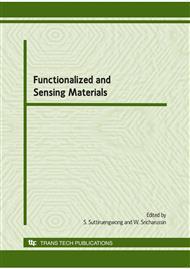p.409
p.413
p.417
p.421
p.425
p.429
p.433
p.439
p.443
Development of Prolonged Action, Bioadhesive and Slowly Dissolving Minitablets
Abstract:
Minitablets can be used either single or multiple unit sustained release dosage form. The objectives of this study were to prepare and evaluate the prolonged action, bioadhesive and slowly dissolving minitablets. The minitablets (Ø 2.5 mm, 7 mg) were prepared by direct compression method using 75%w/w of various hydrophilic polymers: hydroxypropylcellulose (HPC), hydroxypropyl methylcellulose (HPMC), carboxy methylcellulose (CMC), pectin (PT) and chitosan (CS). Spray dried lactose was used as diluent. Prior to compression, the angle of repose, bulk-tab density and %compressibility of each mixed powder were evaluated. The rate of hydration and erosion of the obtained minitablets were carried out in phosphate buffer (pH 7.4). The powder blends containing HPC, CMC or HPMC showed satisfactory flow properties and compressibility. Accordingly, the prepared matrix tablets of HPC, CMC and HPMC showed good physical properties such as hardness, while those of CS and PT showed poor properties. The degree of swelling were ranked as CS>CMC>PT>HPC>HPMC, while the erosion were ranked as CMC≈HPMC≈PT > HPC≈CS. Adhesion time of these minitablets on isolated pig intestine was >30 min for CMC, PT and CS tablets while HPC and HPMC tablets exhibited weaker bioadhesion. In conclusion, among tested polymers, CS, PT and CMC were appropriate for prolonged action, bioadhesive and slowly dissolving minitablets.
Info:
Periodical:
Pages:
425-428
Citation:
Online since:
January 2010
Keywords:
Price:
Сopyright:
© 2010 Trans Tech Publications Ltd. All Rights Reserved
Share:
Citation:


